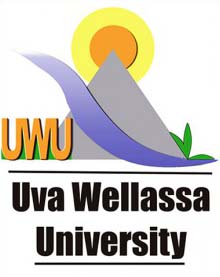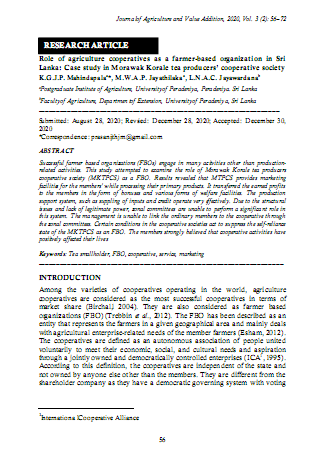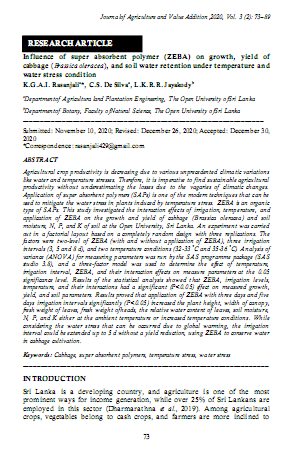
Volume 03 Issue 02
01.Comparative account on antioxidant properties, proximate and phytochemical compositions of seven guava varieties grown in Sri Lanka
S. Kokilananthana, Vajira P. Bulugahapitiyaa*, C.S. Gangabadagea, H. Manawadua
aDepartment of Chemistry, Faculty of Science, University of Ruhuna, Wellamadama, Matara, Sri Lanka
INFORMATION
Journal Title : Journal of Agriculture and Value Addition
Volume : 3 Issue : 2
Page : 01 – 16
Submitted : December 3, 2020; Revised: December 12, 2020; Accepted: December 15, 2020
Correspondence : vajira@chem.ruh.ac.lk
ABSTRACT
Sri Lanka is rich with many guava cultivars/varieties. But, less scientific data are available especially on guava leaves.Therefore, this study was aimed on comparative account of phytochemical and proximate compositions, and antioxidant properties of leaves of seven guava varieties for the purpose of selecting the best variety to be transformed into functional foods and value additions. Extraction of phytochemicals in leaves was undertakenusing two techniquesi.e. maceration and sonication. Screeningfor phytochemicals and investigation of proximate composition werecarried outfollowing standard protocols. Spectrophotometric and gravimetric methods were used in quantification of phytochemicals. DPPH free radical scavenging assay and FRAP reducing power assay were used to measure the antioxidant capacity.Out of two extractions methods applied, sonication showed more efficient. The results showed that the important phytochemicals are available in all the guava varieties with a slight difference among them. High anti-oxidant capacityandacceptable proximate composition were noted with all varieties showing that each has unique characteristic. The statistical analysis and comparison studies showed that common guava is the best variety out of all,showing the highest antioxidant capacity of 722.44±6.58 mg TroloxEq/g in FRAP assay, IC50 value of 192.89±0.07 ppm in DPPH assay, highest polyphenolic content (479.29±2.16 mg GAE/g) and appreciable proximate composition. As a conclusion,this study provided a detailed analysis of phytochemical, proximate and anti-oxidant properties of the leaves of guava varieties grown in Sri Lanka to be used by scientific community for further analysis as well as for applications them into novelfunctional foods to be used in healthcare purposes.
Keywords: Guava varieties, Maceration, Sonication, Phytochemicals, Antioxidant, proximate
2. Effectiveness of farmer field school programme of minor irrigation systems in Hambantota district
M. Wijamunige a and K.K.I.U. Arunakumara a *
a Department of Crop Science, Faculty of Agriculture, University of Ruhuna, Mapalana, Kamburupitiya, Sri Lanka
INFORMATION
Journal Title : Journal of Agriculture and Value Addition
Volume : 3 Issue : 2
Page : 17 – 32
Submitted : June 12, 2020; Revised: August 28, 2020; Accepted: September 2, 2020
Correspondence : vajkkiuaruna@crop.ruh.ac.lk
ABSTRACT
Farmer Field School (FFS) is used for the diagnosis of pest and diseases and make recommendations accordingly with the participation of paddy farmers. In Sri Lanka, FFS has been commenced in the Hambantota district as a pilot project. However, it has now become an institutionalized extension program in all the Agriculture Instructor ranges of the country. The present study was based on the views of 374 FFS participants chosen from Tangalle, Beliatta and, Hambantota divisional secretariats of the Hambantota district and carried out to evaluate the effectiveness of FFS as an extension approach for the management of pests and diseases in paddy cultivation. From the farmers’ point of view, the importance of FFS is twofold: its role as an extension tool and its contribution to promote sustainable agriculture. The majority of the farmers (90%) expressed their satisfaction with the knowledge given by FFS and 95% of farmers have trusted the solutions provided in FFS. According to 90% of farmers, the prescriptions are relevant and appropriate. It was found that FFS has educated farmers on the use of non-chemical pest control methods. FFS has contributed to lessening crop damages, thereby an increase in income from farming. The majority of farmers (92%) showed their satisfaction with the overall activities of FFS, while 6% of farmers were not satisfied. In order to minimize the existing weaknesses and to improve the effectiveness of the present programme, the study proposes: (a) The frequency of conducting FFS should take into account the adult education principle where repeated education is a must; (b) Timing of FFS is important and the critical phases of paddy growth and maturity stage of paddy are when FFS should be held; (c) Content of FFS should be fitted to suit the target group i.e. thorough exposure of major paddy growers through demonstrations on prevention, identification and, control of pests and diseases; (d) Use of advanced teaching aids such as multimedia, lenses, leaflets and, screening of videos and demonstrations; (e) Frequent and thorough training of extension personnel with all the new knowledge on pest and diseases; (f) Ensure the ability to identify pest and disease incidence before it develops into an epidemic by expediting the mapping exercise by the Department of Agriculture.
Keywords: Farmer field school, paddy, integrated pest management, extension approach, Hambantota
3. Evaluation ofrice genotypes for brown planthopper resistance
K.A.K. Wijeseanaa*, S.R. Sarathchandraa, U.A.K.S. Udawelaa, K.M.A.S. Konaraa, J.T.C. Jayasinghea, A.M.E.N. Adhikaria and R.M.S.N. Rathnayakaa
aRice Research & Development Institute, Batalagoda, Ibbagamuwa, Sri Lanka
INFORMATION
Journal Title : Journal of Agriculture and Value Addition
Volume : 3 Issue : 2
Page : 33 – 40
Submitted : June 26,2020; Revised: September 17, 2020: Accepted: September 24, 2020
Correspondence : kamaniwijesena@gmail.com
ABSTRACT
Brown planthopper (Nilaparvatalugens) (BPH) is a major pest of rice in Sri Lanka. Identification of new resistance sources has immense important in varietal improvement programme. Therefore, twenty-five rice genotypes including new improved, exotic and traditional varieties were evaluated for BPH resistance using standard seed box screening technique and honeydew test to identify resistant varieties. During screening Ptb 33 was used as resistant variety. TN1 and Bg 380 were used as susceptible varieties. Bg 380 showed highly susceptible reaction. Ptb 33 had the highest level of BPH resistance with lowest damage score of 3.0. Bg 300, Bg 352, Bg 379-2, Bg 450 and Bw 367 which are popular varieties recorded damage score of 4.7 to 5.6 which categorized as moderately resistant reactions. Similarly, two exotic lines, IR 65482-7-216-2 and IR 71033-121-15 showed moderately resistant reaction too. Among the traditional rice cultivars, Mudukiri el, Horana ma wee, Hondarawala and Mada el showed resistant to moderately resistant reactions.According to the present study,Bg 379-2 and IR 71033-121-15 were the better donor parents for BPH resistance since those varieties having good plant architecture and yield.
Keywords: Brown planthopper,pest,resistant, honeydew test
4. A food risk assessment model based on HACCP for small scale restaurants
H.A.D.C.L. Sandipania, E.K.G.P.U. Dharmarathnab, S.T.C.I.Wimaladharmac,E.D.N.S. Abeyrathnea*
aDepartment of Animal Science, Uva Wellassa University, Badulla, 90000, Sri Lanka
bDepartment of Export Agriculture, Uva Wellassa University, Badulla, 90000, Sri Lanka
cDepartment of Computer Science and Informatics, Uva Wellassa University, Badulla, 90000, Sri Lanka
INFORMATION
Journal Title : Journal of Agriculture and Value Addition
Volume : 3 Issue : 2
Page : 41 – 55
Submitted : October14, 2019; Revised: October 12, 2020; Accepted: October 15, 2020
Correspondence : sandun@uwu.ac.lk
ABSTRACT
Food safety inspection is a crucial factor in small scale restaurants in Sri Lanka due to limited time as a local public health inspector.This is a minor concerned area in their field of working.A food safety management framework was developed to enhance the existing local food inspection process. Personal interviews with health professionals and a pilot survey for restaurants (30) in Badulla were conducted to understand the existing food inspection programme. Then, food risk assessment model based on HACCP for small scale restaurants was developed.In order to facilitate the end-users to use this developed model, an Android food safety application was developed.This model assures the food safety in small scale restaurants and has potential to improve the food safety practices due to its effectiveness and accessibility. Furthermore, “big data” collection through this mobile application can be used for further data analysiscreating multiple research opportunities.
Keywords: Food safety, android food safety application, HACCP, risk assessment model
5. Role of agriculture cooperatives as a farmer-based organization in Sri Lanka: Case study in Morawak Korale tea producers’ cooperative society
K.G.J.P. Mahindapalaa*, M.W.A.P. Jayathilakaa, L.N.A.C. Jayawardana b
aPostgraduate Institute of Agriculture, University of Peradeniya, Peradeniya.Sri Lanka
bFaculty of Agriculture, Department of Extension, University of Peradeniya, Sri Lanka
INFORMATION
Journal Title : Journal of Agriculture and Value Addition
Volume : 3 Issue : 2
Page : 56 – 73
Submitted : August 28, 2020; Revised: December 28, 2020; Accepted: December 30, 2020
Correspondence : prasanjithjm@gmail.com
ABSTRACT
Successful farmer based organizations (FBOs) engage in many activities other than production-related activities. This study attempted to examine the role of Morawak Korale tea producers cooperative society (MKTPCS) as a FBO. Results revealed that MTPCS provides marketing facilities for the members’ while processing their primary products. It transferred the earned profits to the members in the form of bonuses and various forms of welfare facilities. The production support system, such as suppling of inputs and credit operate very effectively. Due to the structural issues and lack of legitimate power, zonal committees are unable to perform a significant role in this system. The management is unable to link the ordinary members to the cooperative through the zonal committees. Certain conditions in the cooperative societies act to suppress the self-reliance state of the MKTPCS as an FBO. The members strongly believed that cooperative activities have positively affected their lives
Keywords: Tea smallholder, FBO, cooperative, service, marketing
6. Influence of super absorbent polymer (ZEBA) on growth, yield of cabbage (Brassica oleracea), and soil water retention under temperature and water stress condition
K.G.A.I. Rasanjaliaa*, C.S.DeSilvaa, L.K.R.R.Jayakody b
aDepartment of Agricultural and Plantation Engineering, The Open University of Sri Lanka
bDepartment of Botany, Faculty of Natural Science, The Open University of Sri Lanka
INFORMATION
Journal Title : Journal of Agriculture and Value Addition
Volume : 3 Issue : 2
Page : 74 – 90
Submitted : November10, 2020; Revised: December26, 2020; Accepted: December 30, 2020
Correspondence : rasanjali429@gmail.com
ABSTRACT
Agricultural crop productivity is decreasing due to various unprecedented climatic variations like water and temperature stresses. Therefore, it is imperative to find sustainable agricultural productivity without underestimating the losses due to the vagaries of climatic changes. Application of super absorbent polymers (SAPs) is one of the modern techniques that can be used to mitigate the water stress in plants induced by temperature stress. ZEBA is an organic type of SAPs. This study investigated the interaction effects of irrigation, temperature, and application of ZEBA on the growth and yield of cabbage (Brassica oleracea) and soil moisture, N, P, and K of soil at the Open University, Sri Lanka. An experiment was carried out in a factorial layout based on a completely random design with three replications. The factors were two-level of ZEBA (with and without application of ZEBA), three irrigation intervals (3, 5 and 8 d), and two temperature conditions (32-33 °C and 35-36 °C). Analysis of variance (ANOVA) for measuring parameters was run by the SAS programme package (SAS studio 3.8), and a three-factor model was used to determine the effect of temperature, irrigation interval, ZEBA, and their interaction effects on measure parameters at the 0.05 significance level. Results of the statistical analysis showed that ZEBA, irrigation levels, temperature, and their interactions had a significant (P<0.05) effect on measured growth, yield, and soil parameters. Results proved that application of ZEBA with three days and five days irrigation intervals significantly (P<0.05) increased the plant height, width of canopy, fresh weight of leaves, fresh weight of heads, the relative water content of leaves, soil moisture, N, P, and K either at the ambient temperature or increased temperature conditions. While considering the water stress that can be occurred due to global warming, the irrigation interval could be extended up to 5 d without a yield reduction, using ZEBA to conserve water in cabbage cultivation.
Keywords: Cabbage, super absorbent polymers, temperature stress, water stress








